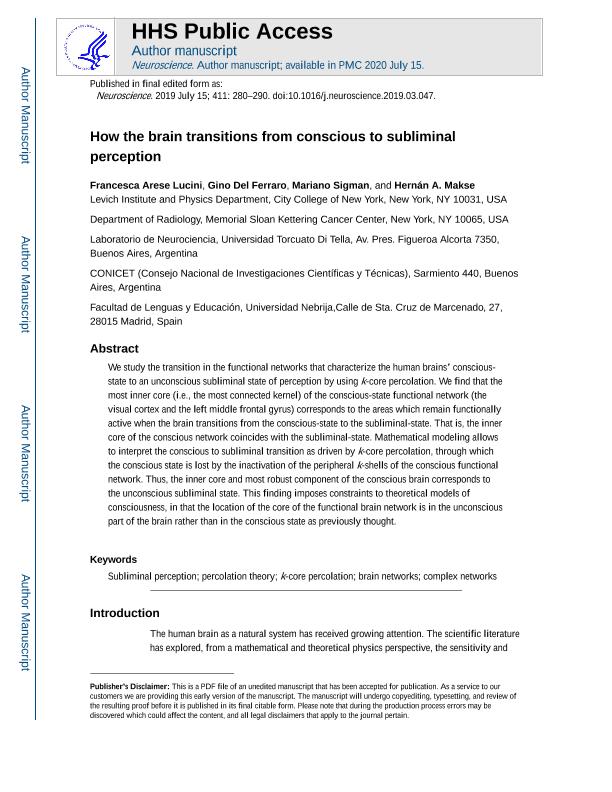Mostrar el registro sencillo del ítem
dc.contributor.author
Arese Lucini, Francesca
dc.contributor.author
Del Ferraro, Gino
dc.contributor.author
Sigman, Mariano

dc.contributor.author
Makse, Hernán Alejandro

dc.date.available
2021-05-20T12:54:10Z
dc.date.issued
2019-07-15
dc.identifier.citation
Arese Lucini, Francesca; Del Ferraro, Gino; Sigman, Mariano; Makse, Hernán Alejandro; How the brain transitions from conscious to subliminal perception; Pergamon-Elsevier Science Ltd; Neuroscience; 411; 15-7-2019; 280-290
dc.identifier.issn
0306-4522
dc.identifier.uri
http://hdl.handle.net/11336/132324
dc.description.abstract
We study the transition in the functional networks that characterize the human brains’ conscious-state to an unconscious subliminal state of perception by using k-core percolation. We find that the most inner core (i.e., the most connected kernel) of the conscious-state functional network corresponds to areas which remain functionally active when the brain transitions from the conscious-state to the subliminal-state. That is, the inner core of the conscious network coincides with the subliminal-state. Mathematical modeling allows to interpret the conscious to subliminal transition as driven by k-core percolation, through which the conscious state is lost by the inactivation of the peripheral k-shells of the conscious functional network. Thus, the inner core and most robust component of the conscious brain corresponds to the unconscious subliminal state. This finding imposes constraints to theoretical models of consciousness, in that the location of the core of the functional brain network is in the unconscious part of the brain rather than in the conscious state as previously thought.
dc.format
application/pdf
dc.language.iso
eng
dc.publisher
Pergamon-Elsevier Science Ltd

dc.rights
info:eu-repo/semantics/openAccess
dc.rights.uri
https://creativecommons.org/licenses/by-nc-sa/2.5/ar/
dc.subject
BRAIN NETWORKS
dc.subject
CONSCIOUS AND SUBLIMINAL PERCEPTION
dc.subject
K-CORE PERCOLATION
dc.subject
PERCOLATION THEORY
dc.subject.classification
Otras Ciencias Naturales y Exactas

dc.subject.classification
Otras Ciencias Naturales y Exactas

dc.subject.classification
CIENCIAS NATURALES Y EXACTAS

dc.title
How the brain transitions from conscious to subliminal perception
dc.type
info:eu-repo/semantics/article
dc.type
info:ar-repo/semantics/artículo
dc.type
info:eu-repo/semantics/publishedVersion
dc.date.updated
2021-05-11T18:14:42Z
dc.journal.volume
411
dc.journal.pagination
280-290
dc.journal.pais
Estados Unidos

dc.description.fil
Fil: Arese Lucini, Francesca. City University of New York. The City College of New York; Estados Unidos
dc.description.fil
Fil: Del Ferraro, Gino. City University of New York. The City College of New York; Estados Unidos. Memorial Sloan-kettering Cancer Center.; Estados Unidos
dc.description.fil
Fil: Sigman, Mariano. Universidad Torcuato Di Tella; Argentina. Consejo Nacional de Investigaciones Científicas y Técnicas; Argentina. Universidad Nebrija;
dc.description.fil
Fil: Makse, Hernán Alejandro. City University of New York. The City College of New York; Estados Unidos
dc.journal.title
Neuroscience

dc.relation.alternativeid
info:eu-repo/semantics/altIdentifier/doi/http://dx.doi.org/10.1016/j.neuroscience.2019.03.047
dc.relation.alternativeid
info:eu-repo/semantics/altIdentifier/url/https://www.sciencedirect.com/science/article/pii/S0306452219302052?via%3Dihub
Archivos asociados
